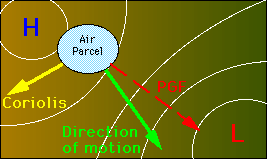| |
|
Coriolis Force (C)
The Coriolis force is caused by the Earth's rotation around its axis. It is a strange force, but plays a very important role in air flow. It is strange because it is based only on latitude, not any meteorological phenomena (although there is some proportionality to wind velocity). The Coriolis force increases as latitude increases. At the equator, it has no effect on horizontal flow. Why is this? Let's look at another, smaller scale example.
 Imagine yourself on a carousel. If you were to roll a ball to the opposite side when the carousel wasn't spinning, it would go straight. But let's start the carousel spinning counter-clockwise (like the earth, if you were looking down on the North Pole). Now if you were to roll a ball, it would seem to deflect to the right from your point of view. Actually, the ball goes straight, but you continue to move.
Imagine yourself on a carousel. If you were to roll a ball to the opposite side when the carousel wasn't spinning, it would go straight. But let's start the carousel spinning counter-clockwise (like the earth, if you were looking down on the North Pole). Now if you were to roll a ball, it would seem to deflect to the right from your point of view. Actually, the ball goes straight, but you continue to move.
 So the Coriolis force is not a real force, but an apparent force due to the earth's rotation and our point of view. However, it behaves as a real force for our point of view (most of us are on earth). In the Northern Hemisphere, the Coriolis force causes moving air parcels to deflect to the right (like the ball and the carousel). In the Southern Hemisphere, moving air parcels get deflected to the left (the force is the same, but looking down on the South Pole, the earth rotates clockwise). The Coriolis force is always directed 90° to the right of the direction of motion (see diagram). The direction of motion is not always in the same direction as the PGF. Remember that the Coriolis force increases as you get closer to the poles. The Coriolis force also increases as an object's velocity increases.
So the Coriolis force is not a real force, but an apparent force due to the earth's rotation and our point of view. However, it behaves as a real force for our point of view (most of us are on earth). In the Northern Hemisphere, the Coriolis force causes moving air parcels to deflect to the right (like the ball and the carousel). In the Southern Hemisphere, moving air parcels get deflected to the left (the force is the same, but looking down on the South Pole, the earth rotates clockwise). The Coriolis force is always directed 90° to the right of the direction of motion (see diagram). The direction of motion is not always in the same direction as the PGF. Remember that the Coriolis force increases as you get closer to the poles. The Coriolis force also increases as an object's velocity increases.
So the Coriolis force depends on four things: the rate of rotation of the Earth ( , which is constant), the mass of the object (m, which is also considered constant), the velocity of the object (V), and the latitude at which it travels ( , which is constant), the mass of the object (m, which is also considered constant), the velocity of the object (V), and the latitude at which it travels ( ). An expression used for the Coriolis force is: ). An expression used for the Coriolis force is:
 . .
Often, the sine term and 2 term are combined into a single variable, f . This is called the Coriolis parameter. Also, the Coriolis force, as are other forces, is usually used in terms that are per unit mass, eliminating the m. Therefore, the expression most often used for the Coriolis force is: term are combined into a single variable, f . This is called the Coriolis parameter. Also, the Coriolis force, as are other forces, is usually used in terms that are per unit mass, eliminating the m. Therefore, the expression most often used for the Coriolis force is:

where  . .
You can use theCoriolis force calculator to investigate the mathematics of this force.
It is the Coriolis force that makes air spiral out of high pressure systems and into low pressure systems. When comparing magnitudes of the PGF and the Coriolis force, the two are more or less of the same magnitude, roughly in geostrophic balance. The Coriolis force, in balance with the PGF, is why air flows around high and low pressure centers. However, one more force plays a role in horizontal motion: friction.
Confused? Have a question? If so, check out the Frequently Asked Questions (FAQ) page or send mail to the OS411 tutor (os411tutor@shodor.org) with your question!
Report technical/content problems here
|
|
 .
.
 .
.